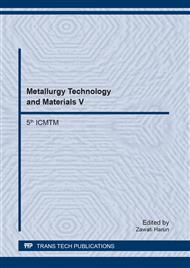[1]
M Chi, R Huang, Binding mechanism and properties of alkali-activated fly ash/slag mortars. Constr. Build. Mater. 40 (2013) 291-298.
DOI: 10.1016/j.conbuildmat.2012.11.003
Google Scholar
[2]
C Li, H Sun, L Li. A review: The comparison between alkali-activated slag (Si+Ca) and metakaolin (Si+Al) cements. Cem. Concr. Res. 40 (2010) 1341-1349.
DOI: 10.1016/j.cemconres.2010.03.020
Google Scholar
[3]
NK Lee, HK Lee. Reactivity and reaction products of alkali-activated fly ash/slag paste. Constr. Build. Mater. 81 (2015) 303-312.
DOI: 10.1016/j.conbuildmat.2015.02.022
Google Scholar
[4]
M Komljenovi´c, Z Bascarevi´c, V Bradi´c. Mechanical and microstructural properties of alkali-activated fly ash geopolymers. J. Hazard. Mater. 181 (2010) 35-42.
Google Scholar
[5]
Y Jun, JE Oh. Mechanical and microstructural dissimilarities in alkali-activation for six Class F Korean fly ashes. Constr. Build Mater 52 (2014) 396-403.
DOI: 10.1016/j.conbuildmat.2013.11.058
Google Scholar
[6]
M Criado, AF Jiménez, I Sobrados, A Palomo, J Sanz. Effect of relative humidity on the reaction products of alkali activated fly ash. J. Eur Ceram Soc 32(2012) 2799-2807.
DOI: 10.1016/j.jeurceramsoc.2011.11.036
Google Scholar
[7]
M Chi, R Huang. Effects of Dosage and Modulus Ratio of Alkali-Activated Solution on the Properties of Slag Mortars. Adv. Sci. Lett. 16(2012) 7-12.
DOI: 10.1166/asl.2012.3313
Google Scholar
[8]
SA Bernal, RMd Gutiérrez, AL Pedraza, JL Provis, ED Rodriguez, S Delvasto. Effect of binder content on the performance of alkali-activated slag concretes, Cem. Concr. Res. 42 (2011) 1-8.
DOI: 10.1016/j.cemconres.2010.08.017
Google Scholar
[9]
M Chi, Effects of dosage of alkali-activated solution and curing conditions on the properties and durability of alkali-activated slag concrete. Constr. Build. Mater. 35 (2012) 240-245.
DOI: 10.1016/j.conbuildmat.2012.04.005
Google Scholar
[10]
AAM Neto, MA Cincotto, W Repette. Drying and autogenous shrinkage of pastes and mortars with activated slag cement. Cem. Concr. Res. 38 (2008) 565-574.
DOI: 10.1016/j.cemconres.2007.11.002
Google Scholar
[11]
C Shi, AF Jiménez, A Palomo. New cements for the 21st century: The pursuit of an alternative to Portland cement. Cem. Concr. Res. 41 (2011) 750-763.
DOI: 10.1016/j.cemconres.2011.03.016
Google Scholar
[12]
I Ismail, SA Bernal, JL Provis, RS Nicolas, S Hamdan, JSJv Deventer. Modification of phase evolution in alkali-activated blast furnace slag by the incorporation of fly ash. Cem. Concr. Compos. 45 (2014) 125-135.
DOI: 10.1016/j.cemconcomp.2013.09.006
Google Scholar
[13]
F-Q Zhao, W Ni, H-J Wang, H-J Liu. Activated fly ash/slag blended cement. Resour. Conserv. Recy. 52 (2007) 303-313.
DOI: 10.1016/j.resconrec.2007.04.002
Google Scholar
[14]
NK Lee, HK Lee. Setting and mechanical properties of alkali-activated fly ash/slag concrete manufactured at room temperature. Constr. Build. Mater. 47 (2013) 1201-1209.
DOI: 10.1016/j.conbuildmat.2013.05.107
Google Scholar
[15]
NK Lee, JG Jang, HK Lee. Shrinkage characteristics of alkali-activated fly ash/slag paste and mortar at early ages. Cem. Concr. Compos. 53 (2014) 239-248.
DOI: 10.1016/j.cemconcomp.2014.07.007
Google Scholar
[16]
F Collins, JG Sanjayan. Strength and shrinkage properties of alkali-activated slag concrete containing porous coarse aggregate. Cem. Concr. Res. 29 (1999) 607–610.
DOI: 10.1016/s0008-8846(98)00203-8
Google Scholar
[17]
F Collinsa, JG Sanjayan. Cracking tendency of alkali-activated slag concrete subjected to restrained shrinkage. Cem. Concr. Res. 30 (2000) 791 - 798.
DOI: 10.1016/s0008-8846(00)00243-x
Google Scholar
[18]
S Bernal, RD Gutierrez, S Delvasto, E Rodriguez. Performance of an alkali-activated slag concrete reinforced with steel fibers. Constr. Build. Mater. 24 (2010) 208 - 214.
DOI: 10.1016/j.conbuildmat.2007.10.027
Google Scholar


